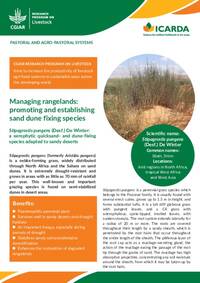Managing rangelands: promoting and establishing sand dune fixing species: Stipagrostis pungens (Desf.) De Winter: a xerophytic quicksand- and dune-fixing species adapted to sandy deserts

Authors:
Stipagrostis pungens is a perennial grass species which belongs to the Poaceae family. It is usually found with several erect culms, grows up to 1.5 m in height, and forms substantial tufts. It is a tall stiff glabrous grass with pungent leaves, and a C4 grass with sclerophyllous, spine-tipped, inrolled leaves, with sunken stomata. The root system extends laterally for a radius of 20 m or more. The roots are covered throughout their length by a sandy sheath, which is penetrated by the root hairs that occur throughout the entire length of the sheath. The piliferous layer of the root cap acts as a mucilage-secreting gland, the action of the mucilage easing the passage of the root tip through the grains of sand. The mucilage has high absorptive properties, concentrating any soil moisture around the sheath, from which it may be taken up by the root hairs.
